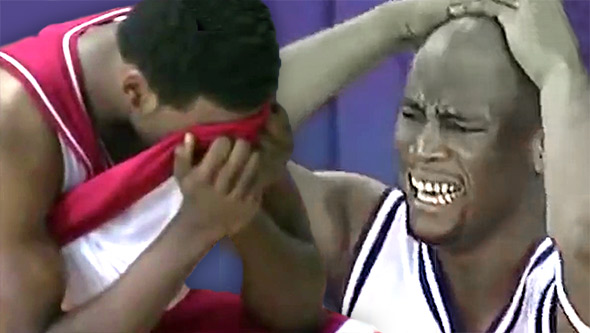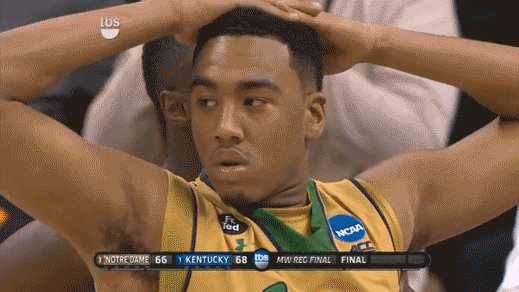The Disappointment Situp
The new body language of college basketball defeat.

Photo illustration by Slate. Screenshots via NCAA/YouTube.
Bonzie Colson, a nervous freshman forward, stood on the sidelines for the final seconds of Notre Dame’s recent Elite Eight game against Kentucky. The Fighting Irish were within a bounce or two of defeating the best team in the tournament, the 11-point-favorite Wildcats, which would have sent them to the Final Four. Colson watched his teammate Jerian Grant dribble to the corner for a three-point shot as time expired, a wild heave to win the game. It was an air ball. As Kentucky players mobbed the court to celebrate, Colson put his hands behind his head.

This was not an unfamiliar sight. In last year’s tournament, Kentucky played Wisconsin in the Final Four, winning on a dramatic three-pointer in the closing seconds. As the buzzer sounded, Kentucky players started leaping up and down, their arms outstretched in victory. If you were watching closely, though, you might have seen Badgers big-man Frank Kaminsky put his elbows up with his hands behind his head, as if he’d been arrested.

Just the week before, Kaminsky had been pumping his fists in celebration when Wisconsin beat the Arizona Wildcats in overtime. But as time expired on that game’s final play, you could see Arizona’s Rondae Hollis-Jefferson pop into the other pose, hands on head in disappointment. A moment later, his teammate Aaron Gordon did the same.

This gesture, the standing situp of defeat, seems to be ubiquitous in college basketball. Once it’s in your mind you’ll start to see it everywhere, a universal sign of sorrow at the ends of games: “Yale’s players were stunned, left holding their hands behind their heads,” wrote the New York Times’ Jeré Longman of the school’s Ivy League playoff loss to Harvard in mid-March. When did putting your hands on your head become a way of showing tribulation on the court?
We’ve had accounts of sports-related body language before, but these tend to focus on the winners: Who figured out that you could spike a football? What’s the history of the high-five? What about the fist-bump and the angry celebration scowl? All good stories, but they’re feel-good stories, too, every one of them—an elaborated history of pride. For every player jumping up and down, there’s another one who kneels and pounds the floor. For every cry of jubilation, someone cries in shame. The language of defeat reveals some unexpected facts about our instinct to display emotion, and how we try to overcome it.
If you want to make a study of athletic sadness, there’s no better set of patients than the players in the NCAA men’s basketball tournament. This must be the most efficient engine of despondency in all of sports: Its very structure—single-game elimination, graduating seniors who may never play again—guarantees a healthy dose of heartache. So I decided to review footage from the closing seconds of March Madness games, going back to 1957. I chose 64 examples from among the most exciting games ever played, as determined by a set of lists like this one in USA Today.
Some things never change: As far back as I looked, losing players slumped their shoulders and stared off into space. They shambled from the court. Starting in the 1980s, I saw them huddle up, support-group style, for some mutual consoling. (You can find a hangdog Patrick Ewing in a huddle after Georgetown’s surprise 1985 loss to Villanova.) Also of long standing are the mopey hands-on-hips and the dejected jersey-tug. Fancier displays, which may be of somewhat more recent vintage, include the sad squat, the lean of languish, and the heartsick horizontal.
What about the disappointment situp? The earliest example that I could find comes from 1990, in a losing player’s flit across the screen, after Christian Laettner made a 14-footer to send Duke to victory over UConn. From there, the hands-on-head gesture slowly gains in popularity, showing up several times during the mid- to late-1990s, and much more often in the past few years.
My data have some problems, though. Not only did I use a small, unbalanced sample—just eight games from before 1980—but there were also major changes in how the games were broadcast. By the 1990s, the networks had settled on a rigid post-game grammar: Show the winning team in celebration, with intermittent cutaways to losers. In early games, the losers got less airtime as a rule, so the full range of their gestures is impossible to see.
Given these constraints, I deferred to body-language experts. David Matsumoto, a San Francisco State University professor of psychology and director of a nonverbal-behavior training company called Humintell, has studied gesture in athletics. For a 2008 paper, he and Jessica Tracy, a psychology professor at the University of British Columbia, studied photos of athletes at both the 2004 Olympic and Paralympic games. They focused on the sport of judo and the expressions made by winners and losers drawn from 37 different countries. Some of the athletes were blind.
Tracy and Matsumoto guessed that certain gestures would be fundamental—that they would show up in athletes from all around the world, whether they could see or not. Indeed, many of the winners seemed to make the same response: heads tilted back, torso pushed out and arms raised high. That’s reminiscent of the “inflated display” that you might see in dominant chimpanzees, among other nonhuman species. The same gestures can be identified as prideful by 4-year-old children, and by people in preliterate societies throughout the world. That is to say, it seems to be innate.
The authors say that corresponding, innate gestures of shame—head tilting downward, slumped shoulders and narrowed chest—are also seen in human groups around the world, and related cringing or lowering behaviors have been observed in chimps, baboons, macaques, rats, rabbits, wolves, elephants, seals, salamanders, and even crayfish. Judo practitioners sometimes showed this response to losing, but the effect was most pronounced among the blind athletes.
Tracy and Matsumoto propose that a learned response to shame can override or cover up more natural gestures. According to Matsumoto, you can spot the innate response within the first half-second of an emotional event. After that, a more self-conscious or culturally determined display kicks in. He thinks that some college basketball players’ gestures are more a product of evolution, such as their tendency to hide their faces, as seen in the montage below.
The hands-on-head pose, Matsumoto says, would be the opposite, a learned display of subordination. “It’s a surrender gesture, like you’d see with prisoners of war.” I pointed out that the situp pose can appear at the very moment of defeat, even as the buzzer sounds. “In some of these cases (at least) they’re pretty fast,” he agreed, “[but] I do not know of any evidence to suggest this is an innate response.”
Jessica Tracy had a somewhat different theory. “My guess is that it’s sort of a regulatory attempt,” she said. The Olympic judo study found that shame displays were rare among North American and Western European athletes. “Shame is so problematic in our culture—it’s such a highly problematized emotion—that we avoid showing it.”
The situp pose, then, might serve as a piece of emotional theater: An athlete lifts his hands in imitation of victory; he brings his elbows up to keep his shoulders from a slouch, then he locks his fingers to cement the pose. The gesture counteracts the instincts of dejection. It’s a way of hiding shame. “That’s a classic power pose, an intentional pride display,” Tracy said. “It’s expansive, it suggests relaxation. It’s saying ‘I control this room.’ ” Think of an executive kicking back during a board meeting, hands clasped behind his head. (Tracy’s work has shown that pride displays have strong effects on viewers, in terms of how they judge the person making gestures.)
The evidence I observed seemed to back up Tracy’s theory. When I watch the players make this gesture, it doesn’t look like giving up, as Matsumoto suggested. It looks more like a way for the defeated players to show the world that they are still ready to act—they’d like to use their arms, but the game is over. That fits better with the idea of papered-over helplessness or put-on pride.
Another data point in Tracy’s favor comes from the fact that winners sometimes make the situp gesture, too. Look at the clip below, from the 1998 game between Connecticut and Washington in which a young Richard Hamilton made a last-second, game-winning shot. Three different players assume the situp pose, two in sadness and one in triumphant disbelief:
I found some other examples of victory sit-ups, too: Duke's Thomas Hill in 1992, Valparaiso’s Antanas Vilcinskas in 1998, UConn’s Jake Voskuhl in 1999.
If Tracy is right, these are the pride displays—shoulders up, chest expanded—that the situp losers are trying to emulate. Or maybe they are more like nonverbal homonyms—a pair of gestures that look the same but hold different meanings. To me, the winner’s situp says, I can’t believe that I just won, and I’m holding my head to prevent it from exploding. The loser version gives a different flavor of the same: I can’t believe that I just lost, and I’m holding my head to keep myself from sinking to the floor.
In any case, it seems to me that the sad situp has gotten more pronounced in recent years, transmitted from one player to another. The dynamics of this fad remain somewhat mysterious. It’s easy to imagine that a prideful gesture, like a football spike, would be copied and repeated. Everyone wants to look like a winner. But why would people copy something losers do?
Maybe this has less to do with emulation than avoidance. Nine years ago last month, Gonzaga’s Adam Morrison, in his last game as a college player, made what might be the most baroque display of disappointment in college basketball history. When his Bulldogs blew their lead and lost to UCLA, Morrison signed an alphabet of shame at center court: He hid his face in his jersey; he leaned over; he fell to the floor; he shifted into sitting pose; he hid his face again; and then finally he rolled over on his belly, convulsing in sobs.
“That’s a testament to him being a competitor,” said Donny Daniels, an assistant coach for UCLA in a recent interview with Yahoo Sports. Many others saw it as pathetic, and Morrison’s display of shame became a running joke. He was still drafted third overall, but his short NBA career—including two championships as a benchwarmer on the Los Angeles Lakers—did nothing to erase the memory of his crying jag.
If players put their hands on their heads today, perhaps it’s because they know the stakes involved. They want to let out their emotions, but they’re afraid of being singled out. So they make a gesture that’s ambiguous and safe, that puffs them up but doesn’t hide their resignation. They do the situp pose because it’s not the Adam Morrison.
*Correction, April 3, 2015: Due to a production error, this caption originally misstated that Illinois beat Arizona in the 2005 NCAA Championship. Illinois’ win was in the Elite Eight.